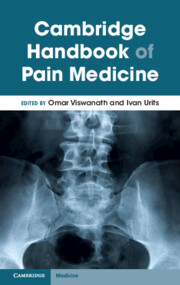Book contents
- Cambridge Handbook of Pain Medicine
- Cambridge Handbook of Pain Medicine
- Copyright page
- Contents
- Contributors
- Pain Handbook Introduction
- Part I Introduction to Pain: Pain Signaling Pathways
- Part II Common Categories of Pharmacologic Medications to Treat Chronic Pain
- Part III Chronic Pain Conditions Head and Neck
- Part IV Spine
- Part V Extremities
- Chapter 18 Carpal Tunnel Syndrome
- Chapter 19 Adhesive Capsulitis of the Shoulder
- Chapter 20 Thoracic Outlet Syndrome
- Chapter 21 Osteoarthritic Hip Pain
- Chapter 22 Osteoarthritic Knee Pain
- Chapter 23 Chronic Ankle and Foot Pain
- Chapter 24 Plantar Fasciitis
- Chapter 25 Phantom Limb Pain
- Part VI Misc
- Part VII Adjunctive Therapy
- Index
- References
Chapter 22 - Osteoarthritic Knee Pain
from Part V - Extremities
Published online by Cambridge University Press: 01 December 2023
- Cambridge Handbook of Pain Medicine
- Cambridge Handbook of Pain Medicine
- Copyright page
- Contents
- Contributors
- Pain Handbook Introduction
- Part I Introduction to Pain: Pain Signaling Pathways
- Part II Common Categories of Pharmacologic Medications to Treat Chronic Pain
- Part III Chronic Pain Conditions Head and Neck
- Part IV Spine
- Part V Extremities
- Chapter 18 Carpal Tunnel Syndrome
- Chapter 19 Adhesive Capsulitis of the Shoulder
- Chapter 20 Thoracic Outlet Syndrome
- Chapter 21 Osteoarthritic Hip Pain
- Chapter 22 Osteoarthritic Knee Pain
- Chapter 23 Chronic Ankle and Foot Pain
- Chapter 24 Plantar Fasciitis
- Chapter 25 Phantom Limb Pain
- Part VI Misc
- Part VII Adjunctive Therapy
- Index
- References
Summary
Osteoarthritis is a common etiology of chronic knee pain and disability associated with aging, weight, and physical inactivity. Global radiographic evidence of knee OA is present in 28.7% of people over 40 years old.Global symptomatic evidence of knee OA is present in 12.4% of people over 40 years old. “Wear and tear” damage to hip joint leading to dysfunctional ECM reorganization leads to chronic onset of pain that is worse with use and associated with decreased knee mobility. Years of conservative treatment with exercise, weight loss, and oral anti-inflammatories can mitigate the disease progression, but severe cases may require intraarticular injections or knee arthroplasty. Some promising injections hope to better manage chronic symptoms by reversing the course of the disease; however, knee arthroplasty remains a gold standard treatment of severe knee OA.
- Type
- Chapter
- Information
- Cambridge Handbook of Pain Medicine , pp. 173 - 180Publisher: Cambridge University PressPrint publication year: 2023

